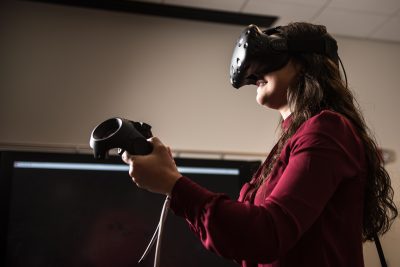 As a top 25 public research and Research 1 university, the University of Connecticut makes both undergraduate and graduate research a priority. Throughout 2018 the university has invested millions of dollars into student enriching programs, they have contributed over $370 million dollars to the Connecticut economy, and they have received over 600 patents granted from UConn technologies. Perhaps what is most encouraging, is the support students receive from their peers, faculty, and the university across all disciplines. Although health behavior, energy, cybersecurity, and neuroscience are their most popular fields, students from psychology and communication have their own research facilities as well.
As a top 25 public research and Research 1 university, the University of Connecticut makes both undergraduate and graduate research a priority. Throughout 2018 the university has invested millions of dollars into student enriching programs, they have contributed over $370 million dollars to the Connecticut economy, and they have received over 600 patents granted from UConn technologies. Perhaps what is most encouraging, is the support students receive from their peers, faculty, and the university across all disciplines. Although health behavior, energy, cybersecurity, and neuroscience are their most popular fields, students from psychology and communication have their own research facilities as well.
In its fourth year, the Research Connections event, held by the First Year Programs and Learning Communities and the Office of Undergraduate Research, was intended to showcase undergraduate research to faculty, staff, graduate students, peers and other key partners. This opportunity was campus-wide, allowing for all students to participate and showcase their work in research. The showcase held students like Pierre Fils and Riley Blumenfield who had ideas on topics like sustainability and health behavior. In his junior year, Fils worked at Climate Change Science Institute at Oak Ridge National Laboratory in Knoxville, Tennessee studying climate-impacted buildings. “That opportunity completely flipped the switch for me when it came to research,” Fils says. “I was engaged in the idea of ‘let’s learn something new, let’s create some new knowledge and let’s figure out how it is that we can do these things that nobody knows about’.” Because of this experience, Fils is hoping to find a way to build homes in Haiti to be earthquake resistant, to prevent catastrophes like the earthquake in 2010. Riley Blumenfield, a Materials Science and Engineering student, Honors Program STEM scholar, and president of engineering sorority Phi Sigma Rho has been working in tissue and regenerative engineering. Last semester, she helped create polymers for mechanical testing, and this semester she’ll follow these polymers through in vitro conditions.
Although the event is meant to showcase the amazing things students are doing at UConn, the university also wants to develop freshmen and sophomores to get them thinking about research then, or in the future. Throughout the program there were student presentations and demos from IDEA Grant recipients and McNair Scholars, activities and presentations from the Learning Community Innovation Zone, and round table discussions with researchers willing to answer questions about their experiences. Thanks to all of the help from the Center for Career Development, First Year Programs and Learning Communities, and Office of Undergraduate Research for encouraging UConn to stay curious!
 This semester OPIM Innovate is hosting open hours for students who are interested in Virtual Reality. On Wednesdays from 9-12 students are welcomed in the Gladstein Lab in the School of Business room 391 to experience the three Virtual Reality options OPIM Innovate has to offer. For beginners, students can experience Google Cardboard, a set of glasses that can fully immerse you in a Virtual Reality experience. For students who may have some experience with VR, the HTC Vive is a more advanced Virtual Reality headset and platform. This headset can transport students into a whole new realm of 3D spaces using sensors and controllers to create hyper-realistic content. For students with advanced Virtual Reality experience, OPIM Innovate has Google Cardboard Camera. Google Cardboard Camera is an app with allows any device to capture and create 3D environments using a phone camera, and they are made visible through Google Cardboard. All three of these options are open to any student who is interested in attending. We hope to see you there!
This semester OPIM Innovate is hosting open hours for students who are interested in Virtual Reality. On Wednesdays from 9-12 students are welcomed in the Gladstein Lab in the School of Business room 391 to experience the three Virtual Reality options OPIM Innovate has to offer. For beginners, students can experience Google Cardboard, a set of glasses that can fully immerse you in a Virtual Reality experience. For students who may have some experience with VR, the HTC Vive is a more advanced Virtual Reality headset and platform. This headset can transport students into a whole new realm of 3D spaces using sensors and controllers to create hyper-realistic content. For students with advanced Virtual Reality experience, OPIM Innovate has Google Cardboard Camera. Google Cardboard Camera is an app with allows any device to capture and create 3D environments using a phone camera, and they are made visible through Google Cardboard. All three of these options are open to any student who is interested in attending. We hope to see you there!